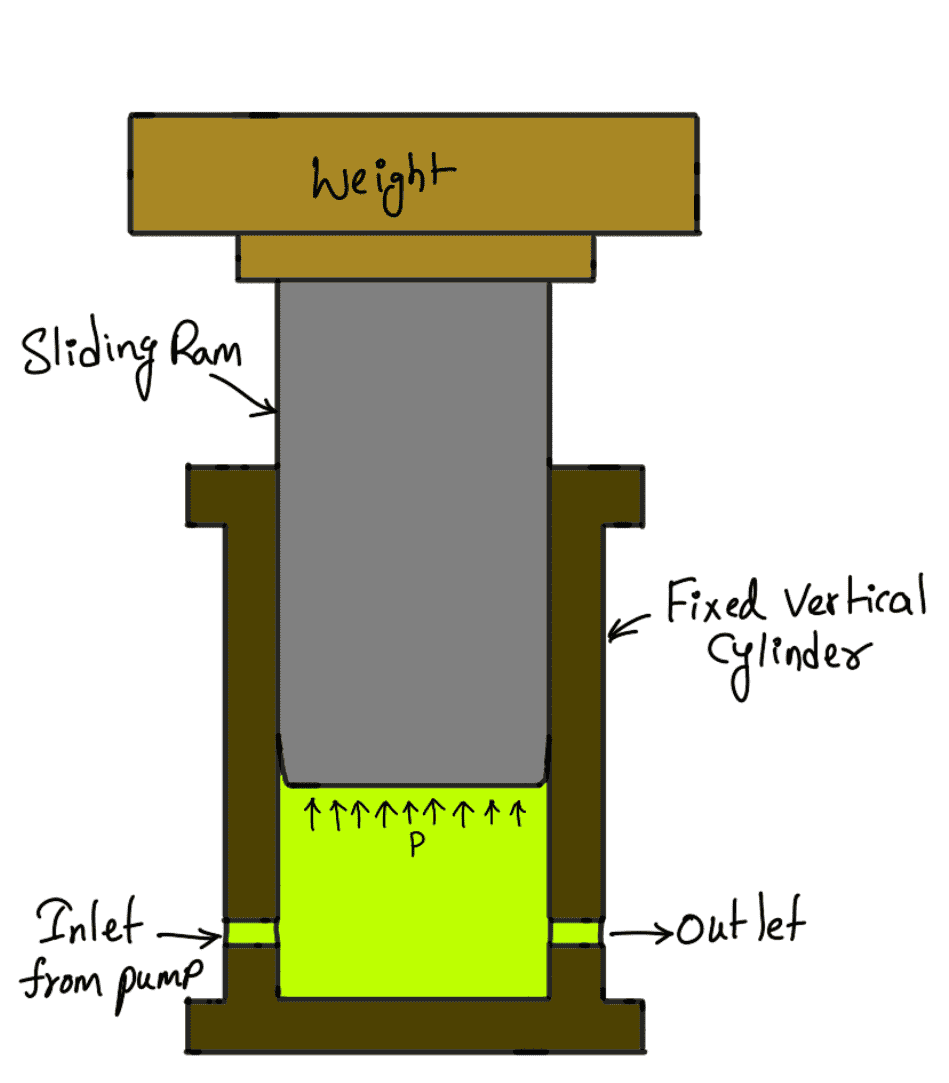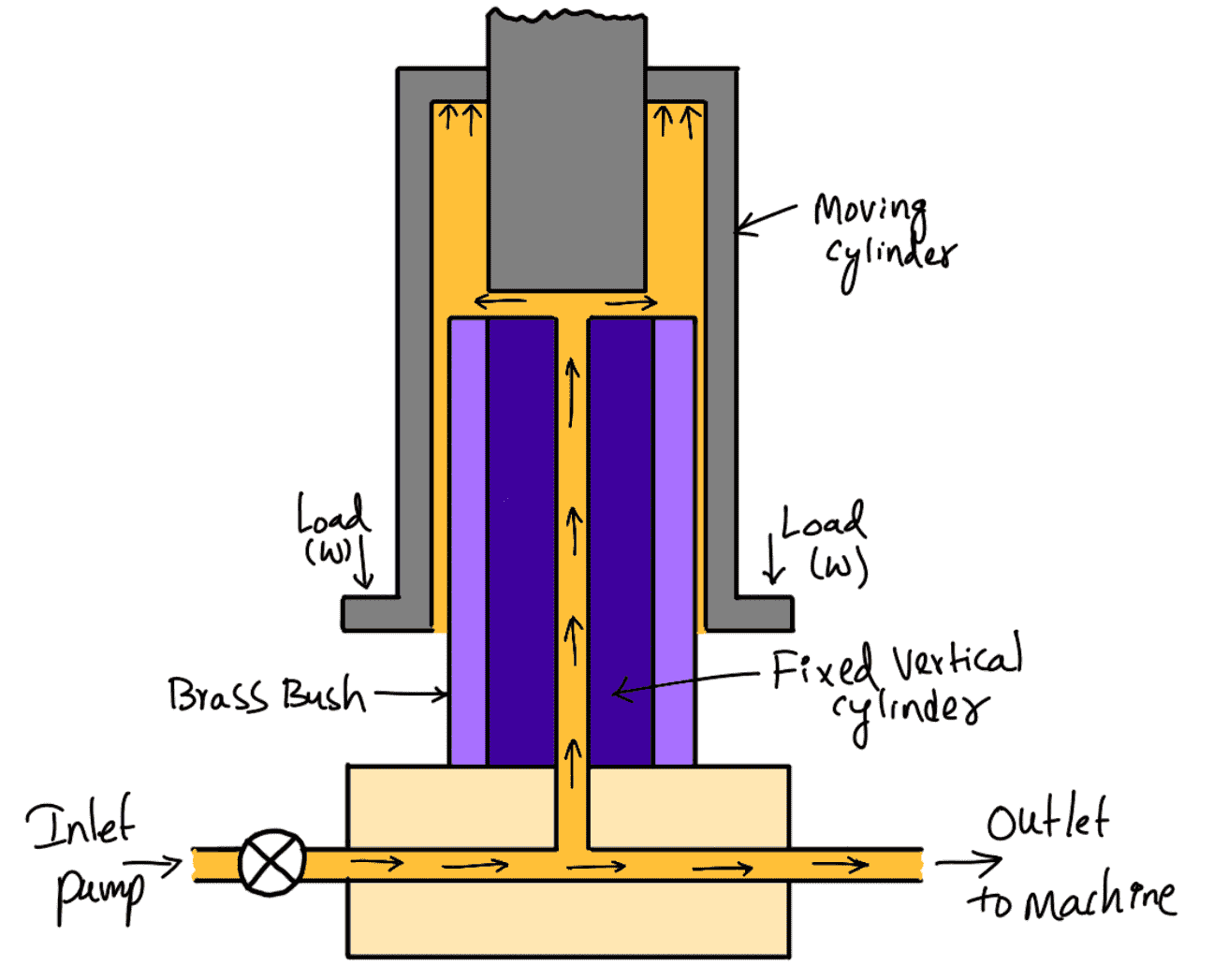The hydraulic accumulator is a device used for storing the energy of a liquid in the form of pressure energy, which may be supplied for any sudden or intermittent requirement. In the case of a hydraulic lift or hydraulic crane, a large amount of energy is required when the lift or crane is moving upward. This energy is supplied by the hydraulic accumulator. Let us discuss more details such as construction, working principle and the Hydraulic Accumulator’s capacity.

Fluid Systems
A fluid system is defined as a device in which power is transmitted with the help of a fluid which may be liquid (water or oil) or a gas (air) under pressure. Most of these devices are based on the principles of fluid statics and fluid kinematics. Following are the different devices that come under the Fluid systems.
- The hydraulic press
- The hydraulic accumulator
- The hydraulic intensifier
- The hydraulic ram
- The hydraulic lift
- The hydraulic crane
- The fluid or hydraulic coupling
- The fluid or hydraulic torque converter
- The Air Lift pump
- The gear-wheel pump
In the previous article, we already discussed the hydraulic press. In this article, we will discuss the hydraulic accumulator. As we mentioned above the hydraulic accumulator is a device used for storing the energy of a liquid in the form of pressure energy, which may be supplied for any sudden or intermittent requirement. In the case of a hydraulic lift or hydraulic crane, a large amount of energy is required when the lift or crane is moving upward. This energy is supplied by the hydraulic accumulator. But when the lift is moving in the downward direction, no large external energy is required and at that time, the energy from the pump is stored in the accumulator.
Hydraulic Accumulator Construction
The following schematic diagram shows a hydraulic accumulator which consists of a fixed vertical cylinder containing a sliding ram. A heavy weight is placed on the ram. The inlet of the cylinder is connected to the pump, which continuously supplies water under pressure to the cylinder. The outlet of the cylinder is connected to the machine (which may be the lift or crane etc.)

Working Principle
- The ram is at the lowermost position in the beginning.
- The pump supplies water under pressure continuously.
- If the water under pressure is not required by the machine (lift or crane), the water under pressure will be stored in the cylinder.
- This will raise the ram on which a heavy weight is placed.
- When the ram is at the uppermost position, the cylinder is full of water and the accumulator has stored the maximum amount of pressure energy.
- When the machine (lift or crane) requires a large amount of energy, the hydraulic accumulator will supply this energy and the ram will move in the downward direction.
Hydraulic Accumulator Capacity
It is defined as the maximum amount of hydraulic energy stored in the accumulator. The expression for the capacity of the accumulator is obtained as:
Let,
A = Area of the sliding ram
L = Stroke or lift of the ram
p = Intensity of water pressure supplied by the pump
W = Weight placed on the ram (including the weight of the ram)
W = Intensity of pressure × Area of ram = p × A
The work done in lifting the ram = W × Lift of ram = W × L = p × A × L
The work done in lifting the ram is also the energy stored in the accumulator. And energy stored is equal to the capacity of the accumulator.
The Capacity of accumulator = Work done in lifting the ram
C = p × A × L
C = p × V
where V is the volume of the Accumulator = A × L
Example Problems with Hydraulic Accumulator
Problem Statement: The water is supplied at a pressure of 14 N/cm2 to the accumulator, having a ram of diameter 1.5m. If the total lift of the ram is 8 m, determine the capacity of the accumulator and the Total weight placed on the ram (including the weight of the ram).
Answer:
Given data
Supply pressure p = 14 N/cm2 = 14 × 104 N/m2
Diameter of ram, D = 1.5m
Lift of ram, L = 8m
Area of ram,

The capacity of the Hydraulic accumulator is given by the equation
C = p × A × L
C = 14 × 104 × 1.767 × 8
C = 1979.04 × 103 Nm
C = 1979.04 kNm
The capacity of the Hydraulic accumulator is 1979.04 kNm.
The total weight (W) placed on the ram is given by
W = p × A
W = 14 × 104 × 1.767
W = 247380 N
The total weight placed on the ram (including the weight of the ram) is 247380N or 25217 kg.
Differential Hydraulic Accumulator
It is a device in which the liquid is stored at high pressure by a comparatively small load on the ram. It consists of a fixed vertical cylinder of a small diameter as shown in the following figure. The fixed vertical cylinder is surrounded by a closely fitting brass bush, which is surrounded by an inverted moving cylinder, having a circular projected collar at the base on which weights are placed.

The liquid from the pump is supplied to the fixed vertical cylinder. The liquid moves up through the small diameter of the fixed vertical cylinder and then enters the inverted cylinder. The water exerts an upward pressure force on the internal annular area of the inverted moving cylinder, which is loaded at the base.
The internal annular area of the inverted moving cylinder is equal to the sectional area of the brass bush. When the inverted moving cylinder moves up, the hydraulic energy is stored in the accumulator.
Let
p = Intensity of pressure of the liquid supplied by a pump
a = Area of brass bush
L = Vertical lift of the moving cylinder
W = Total weight placed on the moving cylinder including the weight of the cylinder = p × a
P = W / a
From the above equation, it is clear that pressure intensity can be increased with a small load W, by making the area ‘a’ small.
Now total energy stored in the accumulator = Total weight × Vertical lift = W × L Nm.
The Capacity of accumulator = Work done in lifting the ram
C = W × L
C = p × a × L
From this relation, you can calculate the capacity of the differential hydraulic accumulator as well. (in newton meters).
This is all about the Hydraulic accumulator and the Differential Hydraulic Accumulator. Let us know what you think about this article in the comment section below.

Leave a Reply